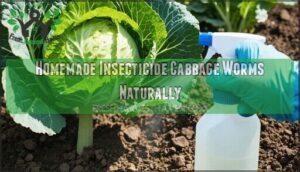This site is supported by our readers. We may earn a commission, at no cost to you, if you purchase through links.

Mix four tablespoons of liquid dish soap with one gallon of water for a basic spray that suffocates these green invaders.
For extra punch, blend garlic cloves and hot peppers with water, then strain and spray directly on affected plants.
Diatomaceous earth works like tiny glass shards against soft-bodied worms when dusted on leaves.
These homemade solutions won’t break the bank or harm your family like store-bought chemicals might. The key is timing your applications right and knowing which method works best for different situations, using methods that are simple, effective, and harmless, with the right ingredients.
Table Of Contents
- Key Takeaways
- Cabbage Worms Overview
- Natural Control Methods
- Homemade Insecticides
- Companion Planting Strategies
- Prevention and Management
- Frequently Asked Questions (FAQs)
- How do you get rid of cabbage worms naturally?
- What pesticide kills cabbage worms?
- What is a natural insecticide for cabbage worms?
- How to naturally get rid of cabbage worms?
- How do you make bug spray for cabbage plants?
- How to clean cabbage worms with vinegar?
- How do cabbage worms survive cold winters?
- Can cabbage worms damage plants other than brassicas?
- What time of day are cabbage worms most active?
- Do cabbage worms have natural deterrents in soil?
- Conclusion
Key Takeaways
- You can make effective homemade sprays using dish soap (4 tablespoons per gallon of water) or garlic-pepper blends that suffocate cabbage worms without harsh chemicals
- You’ll get best results by combining multiple methods – hand-picking worms, applying Bacillus thuringiensis weekly, and using row covers to block egg-laying butterflies
- You should dust diatomaceous earth on wet leaves and plant companion herbs like thyme and rosemary near your cabbage to naturally repel these green pests
- You need to monitor your plants weekly for holes, dark droppings, and pale eggs underneath leaves since early detection prevents severe infestations that can destroy 90% of your crops
Cabbage Worms Overview
You’ll find cabbage worms munching through your prized brassicas like tiny green bulldozers, leaving behind telltale holes and dark droppings that signal trouble in your garden.
These sneaky caterpillars are actually the larvae of common white butterflies, and they can turn your beautiful cabbage, broccoli, or kale into Swiss cheese faster than you can say "harvest time.
Don’t let these green invaders turn your garden dreams into a nightmare—fight back before it’s too late!
Life Cycle of Cabbage Worms
Understanding a cabbage worm’s metamorphosis details helps you tackle these pests at their weakest points.
You’re dealing with a classic four-stage transformation that takes about three to six weeks to complete.
Here’s how their life cycle unfolds:
- Egg development begins when butterflies lay tiny white dots on leaf undersides
- Larval stages involve five growth spurts over 15 days of non-stop munching
- Pupation duration lasts roughly 11 days as they transform into butterflies
- Adult longevity spans three weeks of egg-laying mayhem
To manage these pests effectively, consider organic control methods.
Damage Caused by Cabbage Worms
Once those cabbage worms hatch and start growing, your plants become their all-you-can-eat buffet.
Here’s what cabbage worm damage looks like when these green invaders move in:
- Leaf Hole Patterns appear as irregular holes between leaf veins, creating a Swiss cheese effect
- Fecal Contamination from dark green droppings makes your crops unsafe to eat
- Plant Decay sets in where they’ve chewed through stems and leaves
- Growth Stunted as diseases spread from their feeding damage
- Defoliation Severity can strip plants bare, leaving only thick veins behind
Without proper cabbage worm control, severe infestations turn healthy leaf damage into complete plant damage that’ll ruin your entire harvest.
Identification of Cabbage Worms
Spotting these sneaky green invaders requires a sharp eye since they’re masters of camouflage methods.
Imported cabbage worms appear as velvety green caterpillars with faint yellow stripes, reaching 1.2 inches during their larval development.
The cabbage white butterfly lays tiny pale eggs on host plants like broccoli and kale.
Frass detection is your best clue—look for dark droppings on leaf undersides alongside irregular holes.
Egg identification involves finding yellowish specks, while larval stages progress through five molts.
This cabbage worm identification guide helps you catch infestations before severe leaf damage occurs.
Natural Control Methods
You don’t need harsh chemicals to win the war against cabbage worms – nature’s got your back with plenty of gentle yet effective solutions.
These natural control methods work just as well as store-bought pesticides, and your plants (and wallet) will thank you for choosing the eco-friendly route, with natural control methods being the key to success.
Hand-Picking Cabbage Worms
Getting your hands dirty beats any spray bottle in the matter of cabbage worm control. Manual removal works best during morning hours when caterpillars move slowly.
Check leaf undersides for both worms and eggs—egg removal prevents future problems. Drop collected pests into soapy water for quick elimination.
Timing matters for effective handpicking. Inspect plants every few days since frequency needed increases during peak season. This garden pest control method gives you instant results without chemicals.
Here’s what makes caterpillar control so satisfying:
- You’ll feel like a garden superhero saving your crops
- Kids love helping with this pest-hunting adventure
- Nothing beats the satisfaction of immediate results
Using Bacillus Thuringiensis
Bacillus thuringiensis offers gardeners a powerful yet gentle weapon against stubborn cabbage worms. This naturally occurring soil bacterium specifically targets caterpillar control without harming beneficial insects, making Bt spray the gold standard for natural pest control.
You can find products for this control online.
Here’s your Bt application game plan:
- Spray thoroughly on leaf undersides where caterpillars feed most
- Reapply weekly for 3-4 weeks to break the pest cycle
- Time applications before dry weather since rain washes away protection
- Monitor daily after treatment to gauge Bt effectiveness against remaining pests
Neem Oil and Row Covers
From evening to morning, neem oil creates an effective barrier against cabbage worms when applied at sunset.
This organic certification approved natural pest control prevents leaf burn while repelling pests.
Row covers made from lightweight fabric provide physical protection, blocking egg-laying moths entirely.
Combined effectiveness of both methods offers superior homemade insecticide results compared to single approaches.
Encouraging Beneficial Insects
Row covers protect your plants, but beneficial insects can eliminate cabbage worms entirely. Think of them as your garden’s tiny security team.
Here’s how to recruit nature’s pest patrol:
- Attract Ladybugs with dill and fennel flowers
- Create Lacewing Habitats using diverse plant heights
- Welcome Praying Mantises by avoiding pesticides
- Enjoy Songbird Benefits from berry-producing shrubs
- Consider Duck Patrol for ground-level cleanup
To further bolster defenses, consider how companion planting benefits the garden.
Homemade Insecticides
You don’t need expensive store-bought pesticides when your kitchen cabinets hold the ingredients for powerful homemade solutions.
These simple recipes use common household items like dish soap, garlic, and hot peppers to create effective sprays that’ll send those hungry green worms packing without breaking the bank, making them a homemade alternative.
Soap and Water Solution
Your soap and water solution acts like a gentle suffocator for cabbage worms.
Mix two tablespoons of dish soap per gallon of water – proper soap concentration matters here. This homemade insecticide disrupts the pests’ breathing and makes leaves slippery, causing them to lose their grip.
Spray every three days for ideal application frequency. Use a fine mist spraying technique to coat both leaf tops and undersides thoroughly.
This soapy spray leaves minimal residue effects and won’t harm plant sensitivity when applied correctly. Your DIY pest repellent works fast!
Garlic and Hot Pepper Spray
Moving beyond soapy solutions, garlic and hot pepper spray packs a punch that cabbage worms can’t handle. This homemade insecticide combines nature’s spiciest defenders into one powerful DIY pest repellent. Your natural insecticide works by overwhelming pests with intense flavors they absolutely hate.
Here’s your spray effectiveness boosters:
- Blend 2 garlic bulbs with 6 hot peppers and water
- Add dish soap for better leaf adhesion
- Apply every few days for consistent protection
Recipe variations work with alternative peppers like cayenne. Application frequency matters—reapply after rain. Safety precautions include evening spraying to avoid leaf burn. To maximize its effectiveness, consider evening application methods to avoid harming beneficial insects.
Diatomaceous Earth Powder
While garlic and pepper sprays work great, diatomaceous earth offers a different approach to organic pest control. This powdery homemade insecticide contains microscopic fossils that damage cabbage worms’ soft bodies.
You’ll want food grade DE for safety concerns around edible plants. You can source food grade diatomaceous earth online for your garden.
| Application Method | Coverage Area | Reapplication Time | Notes |
|---|---|---|---|
| Dry Dusting | Light coating | After rain/watering | Most effective method |
| Wet Spray Mix | Even distribution | Weekly intervals | Easier application |
| Soil Amendment | Around plant base | Monthly | Long-term protection |
| Targeted Spots | Problem areas only | As needed | Conservative approach |
The effectiveness debate continues, but many gardeners swear by DE application for natural control methods.
Companion Planting Strategies
You can turn your garden into a natural pest-fighting team by planting the right companions near your cabbage.
Think of it like setting up bodyguards and decoys—some plants repel cabbage worms while others lure them away from your precious crops, acting like decoys.
Repellent Herbs Like Thyme and Rosemary
Your herb garden doubles as a pest-fighting powerhouse when you plant thyme and rosemary near your cabbage.
These aromatic pest repellents release natural oils that send cabbage worms packing while giving you fresh herbs for cooking.
- Thyme pest control works through strong essential oils that mask cabbage scents
- Rosemary companion plants create protective barriers with their woody fragrance
Enjoy culinary herb benefits while maintaining natural pest repellent protection year-round
Trap Crops for Cabbage Worms
Mustard Trap Crops work like decoy ducks for cabbage worms. Plant mustard or nasturtiums nearby to lure pests away from your prized vegetables.
Nasturtium Attraction happens because these flowers smell irresistible to hungry worms.
| Trap Crop | Target Pest | Timing | Removal |
|---|---|---|---|
| Mustard | Cabbage worms | Early spring | Weekly checks |
| Nasturtiums | Various brassica pests | After frost | Remove infested |
| Amaranth | Cabbage loopers | Mid-season | Monthly cleanup |
| Zinnias | Multiple pests | Summer | Regular monitoring |
Crop Rotation keeps pest management effective long-term.
Attracting Beneficial Insects
Beyond trap crops, you’ll want to roll out the red carpet for beneficial insects like ladybugs and lacewings. These tiny warriors become your garden’s pest control squad when you plant the right insectary plants.
Here’s how to create a bug paradise that works in your favor:
- Plant lacewing attractants like dill, fennel, and yarrow to invite these aphid-eating machines
- Install ladybug houses near your cabbage patch to provide shelter for these spotted heroes
- Attract predatory wasps with bird benefits flowers like cosmos and sweet alyssum that double as pollinator magnets
- Mix insect-friendly flowers throughout your garden beds, creating Trichogramma wasp highways between your vegetables
Prevention and Management
You can’t just spray and pray in the case of cabbage worms – smart prevention beats playing catch-up every time.
By combining simple garden cleanup habits with regular monitoring, you’ll stop these green invaders before they turn your prized cabbages into Swiss cheese.
Floating Row Covers and Weed Removal
You can block cabbage butterflies before they strike with floating row covers and smart weed removal. This one-two punch stops egg-laying and eliminates pest hideouts.
For maximum protection, consider purchasing row covers for your garden.
Here’s your action plan:
- Cover Installation – Secure lightweight fabric over crops, allowing air and water through
- Weed Prevention – Pull weeds weekly to remove cabbage worm shelter spots
- Maintenance Tips – Check covers for tears and replace damaged sections promptly
Cleaning Up Garden Debris
Your garden’s winter cleanup isn’t just about looks – it’s serious pest prevention. Those piles of garden debris become five-star hotels for overwintering cabbage worms.
Fall cleanup means removing dead leaves, stems, and plant matter that create debris hiding spots. Turn your soil to expose hidden pupae to hungry birds.
Clean tools prevent spreading problems between plants. This simple disease prevention step supports soil health while breaking pest cycles.
Composting debris properly eliminates future headaches. Proper tool maintenance, including cleaning and oiling, prevents rust and guarantees they’re ready for spring.
Tool sanitation completes your natural control methods arsenal.
Monitoring for Cabbage Worm Infestations
Early detection keeps your cabbage safe from hungry worms. Check leaves weekly for tiny holes, dark green frass (worm droppings), and pale eggs underneath.
Leaf inspection reveals these sneaky pests before they multiply. Different plant varieties show damage differently, so know what’s normal.
Here’s what breaks a gardener’s heart:
- Finding your prize cabbage stripped bare overnight
- Discovering worms when you’re ready to harvest
- Watching weeks of hard work disappear
Combining Natural Control Methods
You’ve spotted the signs—now it’s time to fight back with multiple weapons. Integrated Pest Management works best when you layer your defenses.
Combine these natural pest control methods for maximum impact:
- Apply homemade insecticide like soap and water solution weekly
- Use Synergistic Control Methods with Bt and neem oil together
- Implement Long-Term Strategies through Crop Rotation Impact
Smart gardeners know teamwork beats cabbage worms every time!
Frequently Asked Questions (FAQs)
How do you get rid of cabbage worms naturally?
Picture tiny green invaders munching through your prized cabbage leaves like a buffet.
You’ll handpick these pests, spray soapy water solutions, sprinkle Bt powder, or attract helpful predators like ladybugs to reclaim your garden naturally.
What pesticide kills cabbage worms?
You’ll find Bacillus thuringiensis (Bt) works like magic against cabbage worms.
This organic pesticide specifically targets caterpillars without harming beneficial insects.
Neem oil also kills them while deterring egg-laying moths effectively.
What is a natural insecticide for cabbage worms?
Cabbage worms destroy up to 90% of crops if left unchecked.
You can make effective natural insecticides using dish soap mixed with water, neem oil spray, or garlic-pepper blends that safely eliminate these hungry green pests.
How to naturally get rid of cabbage worms?
You’ll crush these green invaders using simple kitchen ingredients.
Mix dish soap with water, spray Bt weekly, hand-pick worms into soapy water, or sprinkle cornmeal on wet leaves to make them swell and die.
How do you make bug spray for cabbage plants?
Like mixing a magic potion, you’ll blend 2 tablespoons dish soap with 1 gallon water. Add cayenne pepper for extra punch. Spray thoroughly on cabbage leaves, coating tops and undersides completely.
How to clean cabbage worms with vinegar?
Soak your harvested cabbage in a vinegar and water solution for 15-20 minutes.
This gentle bath removes stubborn worms hiding in leaves without harsh chemicals, making your vegetables safer to eat.
How do cabbage worms survive cold winters?
Surprisingly, 90% of cabbage worms don’t actually survive freezing temperatures.
They overwinter as pupae tucked under garden debris, mulch, or soil.
You’ll find them emerging as butterflies when spring warmth returns to restart their cycle.
Can cabbage worms damage plants other than brassicas?
Cabbage worms primarily target brassicas like cabbage, broccoli, and kale, but they’ll occasionally munch on related plants like nasturtiums and radishes.
You won’t find them damaging tomatoes or peppers though—they’re pretty picky eaters!
What time of day are cabbage worms most active?
You’ll spot these green munchers most actively during cooler morning and evening hours.
They’re basically vampires of the garden world – avoiding hot midday sun by hiding under leaves, then emerging to feast when temperatures drop.
Do cabbage worms have natural deterrents in soil?
Like nature’s security system, soil doesn’t naturally repel cabbage worms since they’re aerial invaders.
You’ll need to create your own barriers—beneficial microbes and nematodes can help, but they won’t stop butterfly eggs from landing above.
Conclusion
Like David facing Goliath with just a slingshot, you now have seven powerful weapons against cabbage worms using simple household items.
These homemade insecticide cabbage worms solutions prove you don’t need expensive chemicals to protect your garden, from soapy water to diatomaceous earth, each method offers a safe, effective way to reclaim your crops.
Remember, consistency beats perfection—regular applications and combining multiple strategies will keep those green invaders at bay while protecting your family and wallet.












